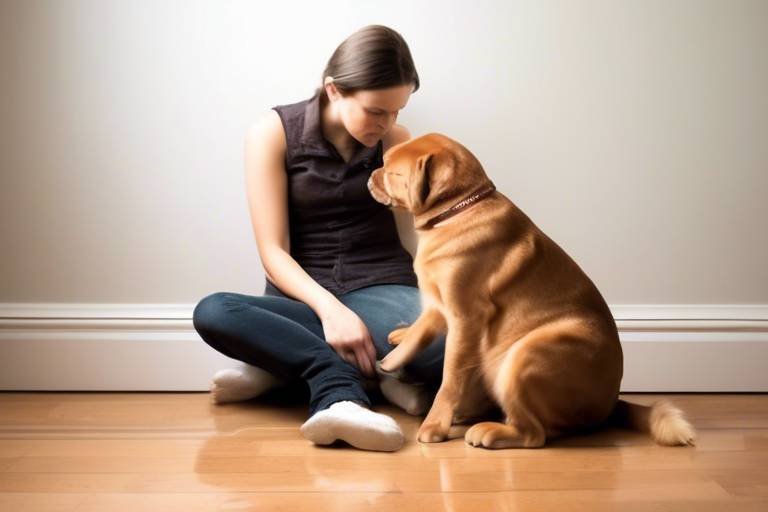How to Train Your Dog to Use a Pet Door
Training your dog to use a pet door can be a game-changer for both you and your furry friend. Imagine the convenience of letting your dog come and go as they please without the constant need for you to open the door. This not only makes your life easier but also allows your dog the freedom to explore the outdoors whenever they want. In this comprehensive guide, we will walk you through the steps to effectively train your dog to use a pet door, ensuring that the process is smooth, enjoyable, and successful.
Before diving into the training process, it's crucial to understand the different types of pet doors available. Pet doors come in various styles, including flap doors, electronic doors, and sliding doors. Each type has its own features that cater to different needs. For example, a flap door is simple and economical, while an electronic door can offer enhanced security by only opening for your pet's microchip. Choosing the right pet door will set the stage for successful training. Consider your dog's size, temperament, and your home environment when making your selection.
Preparation is key when it comes to training your dog to use a pet door. Before you even think about the door itself, ensure that your dog is mentally and physically ready for this new challenge. Take some time to assess your dog's behavior and personality. Is your dog naturally curious, or are they more reserved? Understanding their temperament will help you tailor your training approach for better results.
Take a moment to observe how your dog interacts with doors in general. Have they had positive experiences, or do they seem apprehensive? If your dog has shown fear or anxiety around doors in the past, this will be an important factor to consider when training them to use a pet door. The more you know about your dog's behavior, the easier it will be to create a comfortable training environment.
Recognizing any fears or anxieties your dog may have about the pet door is crucial. For instance, if your dog has had a negative experience with a door slamming shut, they may be hesitant to approach the pet door. Addressing these issues early can prevent setbacks during training. You might want to introduce the pet door gradually, allowing your dog to become familiar with it without pressure.
Establishing a trusting relationship with your dog is vital for successful training. Spend quality time with your dog, engaging in activities that make them feel safe and happy. This could include playtime, grooming, or simply lounging together. The more your dog trusts you, the more likely they will be to explore the pet door without fear. Remember, patience is key—celebrate small victories along the way!
The placement of the pet door can significantly impact your dog's willingness to use it. Ideally, you want to select a location that is easily accessible and familiar to your dog. A spot that they frequently visit, such as the back door leading to the yard, can help facilitate a smoother training process. If the pet door is in a high-traffic area, make sure to monitor interactions to ensure your dog feels safe and comfortable.
Now that your dog is prepared, let's dive into the various training techniques you can implement. The goal is to teach your dog how to use the pet door effectively while ensuring they feel comfortable and confident in their movements.
Using positive reinforcement techniques, such as treats and praise, can be incredibly effective in motivating your dog to approach and use the pet door. Every time your dog makes an effort to go near the door or even touches it with their nose, reward them with a treat and enthusiastic praise. This creates a positive association with the pet door, encouraging them to use it more often.
Introducing the pet door gradually is essential. Start by allowing your dog to explore the door while it's propped open. Let them sniff it, walk around it, and get used to its presence. Once they're comfortable, you can begin to close the door partially, encouraging them to push it open. This method reduces stress and increases the likelihood of successful usage, as your dog can adjust at their own pace.
Training your dog to use a pet door may come with its fair share of challenges. Let’s address some common issues and provide practical solutions to help you overcome them.
If your dog shows reluctance to use the pet door, understanding the underlying reasons can help you implement effective strategies. Perhaps they are unsure about what lies on the other side. To combat this, you can encourage them to see what's outside by calling them or tossing a favorite toy just beyond the door. Gradually, they will build the confidence to venture through on their own.
Ensuring your dog's safety while using the pet door is paramount. Discuss potential safety concerns, such as the door closing unexpectedly or unwanted animals entering your home. Consider installing a pet door with a locking mechanism or an electronic door that only opens for your pet. This way, you can feel more secure during the training process, knowing your dog is safe.
- How long does it take to train a dog to use a pet door? The duration can vary based on your dog's temperament, but most dogs can learn to use a pet door within a few days to a couple of weeks.
- What if my dog refuses to use the pet door? If your dog is hesitant, go back to basics. Use positive reinforcement and ensure they feel safe and comfortable around the door.
- Can all dogs use a pet door? Most dogs can use a pet door, but consider the size and weight of the door in relation to your dog's breed and size.

Understanding Pet Doors
This article provides a comprehensive guide on training your dog to use a pet door effectively, ensuring convenience for both you and your furry friend.
When it comes to pet doors, there are a variety of options available that cater to different needs and preferences. Understanding the types of pet doors can greatly influence your choice and ultimately your dog's comfort. Pet doors come in various styles, including flap doors, electronic doors, and sliding doors, each with its unique features. For instance, flap doors are the most common type, allowing pets to push through a flexible flap, while electronic doors require a special collar to activate, providing added security by limiting access to only your pet.
Additionally, the material of the pet door is crucial. You can find doors made from plastic, aluminum, or wood, each offering different levels of durability and insulation. If you live in a region with extreme weather, opting for an insulated door can help maintain your home's temperature and save on energy costs. Consider your dog's size when choosing a door; it should be large enough for them to pass through comfortably but not so large that it compromises your home's security.
Here’s a quick comparison of different types of pet doors:
| Type of Pet Door | Features | Best For |
|---|---|---|
| Flap Door | Simple design, easy for pets to use | Most dogs, especially those who enjoy independence |
| Electronic Door | Operates with a collar sensor, secure | Homes with multiple pets or security concerns |
| Sliding Door | Integrates with existing sliding doors | Aesthetically pleasing, ideal for patio access |
Choosing the right pet door not only enhances your dog’s experience but also contributes to your home’s functionality. A well-selected pet door can serve as a gateway to freedom for your dog, allowing them to enjoy the outdoors while giving you peace of mind. Remember, the goal is to make your dog feel comfortable and safe using their new door, so take the time to explore all available options!
Before starting the training process, it's essential to prepare your dog mentally and physically, ensuring they are comfortable and ready to learn how to use the pet door.
Understanding your dog's temperament and previous experiences with doors will help tailor the training approach for better results, making the process smoother and more effective.
Recognizing any fears or anxieties your dog may have about the pet door is crucial. Addressing these issues early can prevent setbacks during training.
Establishing a trusting relationship with your dog will encourage them to explore the pet door without fear, making the training experience more positive and successful.
The placement of the pet door significantly impacts your dog's willingness to use it. Selecting an accessible and familiar location can facilitate a smoother training process.
Explore various training techniques you can implement to teach your dog how to use the pet door effectively, ensuring they feel comfortable and confident in their movements.
Using positive reinforcement techniques, such as treats and praise, can motivate your dog to approach and use the pet door, reinforcing good behavior throughout the training process.
Introducing the pet door gradually will help your dog adjust to it at their own pace. This method reduces stress and increases the likelihood of successful usage.
Training your dog to use a pet door may come with challenges. This section addresses common issues and provides practical solutions to help you overcome them.
If your dog shows reluctance to use the pet door, understanding the underlying reasons can help you implement effective strategies to encourage them to try.
Ensuring your dog's safety while using the pet door is paramount. Discussing potential safety concerns and how to mitigate them can help you feel more secure in the training process.
Here are some common questions pet owners have when training their dogs to use a pet door:
- How long does it take to train a dog to use a pet door? - The time varies by dog, but with consistent training, many dogs learn within a few days to a couple of weeks.
- Can all dogs use a pet door? - Most dogs can, but some may need extra encouragement or training, especially if they have had negative experiences with doors in the past.
- What if my dog is too small for the pet door? - Ensure you choose a door that suits your dog's size, or consider a smaller door designed specifically for smaller breeds.

Preparing Your Dog for Training
Before diving into the exciting journey of training your dog to use a pet door, it's crucial to set the stage for success. Just like any new adventure, preparation is key! Think of it as packing your bags before a trip; you wouldn’t want to forget anything important, right? The same goes for your furry friend. You want to ensure they are mentally and physically ready to embark on this training journey.
First things first, assess your dog's current behavior. Are they generally curious and adventurous, or do they tend to be a bit timid? Understanding your dog’s temperament can significantly influence the training approach you choose. If your dog is naturally inquisitive, they may take to the pet door like a duck to water. However, if they’re more reserved, you might need to employ extra patience and encouragement.
Take a moment to observe your dog in various situations. Does your pup shy away from new experiences? Or do they eagerly explore their surroundings? This assessment will help you tailor your training techniques. For instance, if your dog has had negative experiences with doors in the past, you’ll want to approach the training with extra care. A gentle introduction can work wonders.
Next, let’s talk about fears and anxieties. Just like humans, dogs can have their own set of worries. Is your dog anxious about loud noises or sudden movements? If so, these fears might translate to reluctance when it comes to using the pet door. Addressing these issues early on is crucial to prevent setbacks during training. You might want to create a calm environment where your dog feels safe and secure. Consider using soothing music or even a favorite toy to help ease their nerves.
Building a strong bond of trust with your dog is essential. Think of it as a foundation for a house; without a solid base, everything else can crumble. Spend quality time with your dog, engage in play, and shower them with love and attention. This relationship will encourage them to explore the pet door without fear. Remember, a confident dog is more likely to embrace new experiences, including using that shiny new pet door you’ve installed!
Now that you’ve prepared your dog mentally, let’s talk about the physical setup. The location of the pet door can make a world of difference in the training process. You want to place the door in a spot that is easily accessible and familiar to your dog. Consider areas where they already spend time, like the back door leading to the yard. If they can see their favorite spot outside, they’ll be much more inclined to use the door!
In summary, preparing your dog for training is a multi-faceted process that requires attention to their behavior, fears, and the training environment. By taking the time to understand your dog and setting the right conditions, you’ll pave the way for a successful training experience. Remember, patience and positivity are your best friends in this journey!
- How long does it typically take to train a dog to use a pet door?
Every dog is different, but with consistent training, many dogs can learn to use a pet door within a few days to a couple of weeks. - What if my dog refuses to use the pet door?
It's essential to identify any fears or anxieties your dog may have. Gradual exposure and positive reinforcement can help overcome reluctance. - Can I train an older dog to use a pet door?
Absolutely! While younger dogs may adapt more quickly, older dogs can learn new behaviors too, especially with patience and encouragement. - Are there any safety concerns with pet doors?
Yes, it’s important to ensure the pet door is secure and that it doesn’t pose any risks for your dog, such as sharp edges or getting stuck.
Assessing Your Dog's Behavior
Before diving headfirst into training your dog to use a pet door, it's crucial to take a step back and assess your dog's behavior. This foundational understanding will not only make the training process smoother but also more enjoyable for both you and your furry friend. Dogs, much like humans, have unique personalities and experiences that shape their reactions to new situations. By evaluating your dog's temperament, you can tailor your training approach to fit their specific needs and quirks.
Start by observing how your dog interacts with doors in general. Does your pup eagerly rush to the door when it opens, or do they hang back, unsure of what to do? This can give you insight into their level of curiosity and confidence. For instance, a dog that is naturally inquisitive might take to the pet door like a fish to water, while a more timid dog may require a gentle nudge to get started. Understanding these behaviors is key to a successful training experience.
Additionally, consider your dog's previous experiences with doors. Have they ever had a negative encounter, such as getting stuck or being startled by a closing door? If so, these past incidents could lead to anxiety or reluctance when faced with the new pet door. It's essential to recognize these fears and address them early on. A dog that associates doors with fear might need extra encouragement and reassurance during the training process.
To help assess your dog's behavior effectively, you can keep a simple log of their reactions to various situations involving doors. Here’s a quick table you can use to track their progress:
| Date | Situation | Dog's Reaction | Notes |
|---|---|---|---|
| MM/DD/YYYY | Approaching the door | Curious/Timid | Specify what happened |
| MM/DD/YYYY | Using the pet door | Successful/Failed | Details about success or failure |
By keeping track of your dog's behavior, you can identify patterns and adjust your training methods accordingly. For instance, if you notice that your dog is more receptive to training in the morning rather than the evening, you can schedule your training sessions to align with their peak energy levels. This kind of thoughtful approach not only enhances the training experience but also strengthens the bond between you and your dog.
In conclusion, assessing your dog's behavior is a critical step in the training process. By understanding their temperament, past experiences, and reactions to various situations, you can create a tailored training plan that addresses their specific needs. Remember, patience and observation are your best friends in this journey. With the right approach, your dog will soon be zipping through that pet door like a pro!
- How long does it typically take to train a dog to use a pet door? The time varies based on the dog's personality and previous experiences, but with consistent training, many dogs learn within a few days to a few weeks.
- What if my dog refuses to use the pet door? It's essential to assess any fears or anxieties they might have. Gradual exposure and positive reinforcement can help alleviate their reluctance.
- Can all dogs learn to use a pet door? Most dogs can learn to use a pet door, but some may require more time and patience, especially if they have had negative experiences with doors in the past.
- Are there specific types of pet doors that are better for certain breeds? Yes, larger breeds might need sturdier doors, while smaller breeds may require doors that are easier for them to push open.
Identifying Fears and Anxieties
When it comes to training your dog to use a pet door, is a crucial step that should never be overlooked. Just like humans, dogs can have their own set of fears that may stem from past experiences or their innate temperament. For instance, if your dog has had a negative encounter with a door or an unfamiliar object, it might approach the pet door with hesitation or outright fear. This is where your observational skills come into play. Pay close attention to your dog’s body language when they are near the pet door. Are they cowering, barking, or showing signs of stress? These behaviors are red flags indicating that your furry friend may not be ready to embrace the new addition to your home.
To effectively tackle these anxieties, it’s essential to create a comfortable environment for your dog. Begin by allowing them to explore the pet door at their own pace. You can encourage this by using treats or their favorite toys to create a positive association with the door. For example, place a few treats on the ground leading up to the door, gradually moving them closer until they reach the threshold. This method not only makes the door less intimidating but also helps build their confidence.
Moreover, understanding the specific fears your dog may have can help you tailor your training approach. Here are some common fears and anxieties to look out for:
- Noise Sensitivity: Some dogs might be startled by the sound the door makes when it swings open or closed.
- Size and Shape: A large or heavy pet door might appear daunting to a smaller dog, making them hesitant to approach.
- New Environment: If the pet door leads to a new area, your dog might be anxious about venturing into unknown territory.
Once you identify any fears, it’s important to address them with patience and understanding. Remember, pushing your dog too quickly can lead to setbacks, so take your time. The goal is to turn the pet door from a source of anxiety into a gateway of adventure! By gradually exposing your dog to the pet door and reinforcing positive behavior, you’ll help them overcome their fears. This not only makes the training process smoother but also strengthens the bond between you and your furry companion.
In summary, recognizing and addressing your dog’s fears and anxieties is a foundational step in training them to use a pet door. By being attentive and supportive, you can help your dog navigate their apprehensions, leading to a more enjoyable and successful training experience.
Q: How long does it typically take to train a dog to use a pet door?
A: The time varies depending on the dog's temperament and previous experiences, but with consistent training, most dogs can learn within a few days to a couple of weeks.
Q: What if my dog refuses to go through the pet door?
A: If your dog is reluctant, revisit the training techniques, ensuring they feel safe and comfortable. You might need to slow down the process and use more positive reinforcement.
Q: Are there specific breeds that are more difficult to train for using a pet door?
A: While every dog is unique, some breeds may be more naturally hesitant. It's essential to tailor your approach based on your dog's individual personality rather than their breed alone.
Q: Can I train an older dog to use a pet door?
A: Absolutely! While it may take a bit longer, older dogs can learn new tricks too. Just be patient and use gentle encouragement.
Building Trust and Confidence
Building trust and confidence with your dog is an essential step in the training process, especially when introducing them to a new pet door. Think of it as laying a strong foundation for a house; without that solid base, everything else can come crashing down. Your furry friend needs to feel safe and secure before they can embrace this new experience. Start by creating a calm and inviting atmosphere around the pet door. You can do this by allowing your dog to explore the area without any pressure. Use their favorite toys or treats to create positive associations with the door.
Additionally, consider the following strategies to help build trust:
- Be Patient: Every dog learns at their own pace. If your dog seems hesitant, give them time to adjust. Rushing the process can lead to anxiety and setbacks.
- Use Encouragement: Encourage your dog with a cheerful voice and gentle body language. Dogs are incredibly intuitive and can pick up on your emotions. If you appear relaxed and happy, they will likely feel the same.
- Practice Together: Spend time near the pet door with your dog, encouraging them to come close. You can even sit on the ground with them, making the experience feel less intimidating.
Another effective technique is to reward your dog for any progress they make, no matter how small. If they approach the door, give them a treat or lots of praise. This positive reinforcement will encourage them to try again. Remember, building trust is not a race; it’s a journey. Celebrate the small victories along the way, as they will lead to greater confidence in the long run. With a little time and effort, your dog will not only learn to use the pet door but will also feel secure and happy doing so.
Q1: How long does it typically take to train a dog to use a pet door?
A1: The time it takes can vary widely depending on the dog’s temperament and previous experiences. Some dogs may learn within a few days, while others might take weeks. Patience is key!
Q2: What if my dog is scared of the pet door?
A2: If your dog shows fear, take a step back. Use positive reinforcement and allow them to explore the door at their own pace. Gradually introduce them to the door, ensuring they feel safe.
Q3: Can I train an older dog to use a pet door?
A3: Absolutely! Older dogs can learn new tricks just like younger ones. The approach may need to be more gradual, but with patience and encouragement, they can adapt.
Q4: Are there specific types of pet doors that are better for training?
A4: Yes, some pet doors are designed with features that make them easier for dogs to use, such as flexible flaps or automatic sensors. Choosing a user-friendly design can help facilitate the training process.
Choosing the Right Location
Choosing the right location for your pet door is crucial for a successful training experience. Imagine trying to navigate a maze blindfolded – that’s how your dog might feel if the door is placed in an awkward or unfamiliar spot. You want to select a location that is not only accessible but also familiar to your furry friend. A well-placed pet door can make all the difference in encouraging your dog to use it confidently.
Start by considering where your dog spends most of their time. Is it the living room, kitchen, or perhaps the backyard? Placing the pet door in a spot that connects these areas will make it easier for your dog to understand its purpose. Additionally, think about the flow of your home. A door that leads directly outside, without any obstacles in the way, will help your dog feel more comfortable using it. If there are steps or tight corners, it might be worth reconsidering the location.
Another factor to consider is the weather. If you live in an area with extreme temperatures, placing the pet door in a sheltered area can protect your dog from the elements while they come and go. For instance, a door leading into a garage or a covered porch can provide a safe haven from rain or snow. This way, your dog will feel more inclined to use the door, as they won’t be met with unpleasant weather conditions.
To help visualize the best locations, here’s a quick table summarizing key factors to consider:
| Location Factor | Considerations |
|---|---|
| Accessibility | Ensure the door is easy to approach without obstacles. |
| Familiarity | Choose a spot your dog is comfortable with. |
| Weather Protection | Consider placing the door in a sheltered area. |
| Visibility | Make sure the door is visible from where your dog usually hangs out. |
Lastly, pay attention to your dog’s behavior during the training process. If they seem hesitant or confused, it might be a sign that the location isn’t ideal. Be flexible and willing to move the pet door if necessary. After all, the goal is to create a positive experience for your pet. Remember, a well-placed pet door can lead to greater independence for your dog and less hassle for you!
- How long does it take for a dog to learn to use a pet door? It varies by dog, but with consistent training, most dogs can learn within a few days to a couple of weeks.
- What if my dog is afraid of the pet door? Gradually introduce them to the door, using treats and encouragement to build their confidence.
- Can I install a pet door in a glass door? Yes, there are pet doors specifically designed for installation in glass doors.
- What size pet door should I choose? Measure your dog’s height and width to ensure a comfortable fit; typically, the door should be at least 2 inches taller and wider than your dog.

Training Techniques
Training your dog to use a pet door can be a rewarding experience, both for you and your furry companion. The key to success lies in using effective that cater to your dog's unique personality and learning style. One of the most effective methods is positive reinforcement. This technique involves rewarding your dog with treats, praise, or playtime whenever they approach or use the pet door. By associating the door with positive experiences, your dog will be more likely to return to it. Imagine your dog as a little explorer, and every time they venture through the door, you’re giving them a high-five for their bravery!
Another useful approach is the gradual introduction of the pet door. Instead of expecting your dog to dash through the door on their first try, allow them to explore it at their own pace. Start by propping the door open and encouraging your dog to walk through it. You can use enticing toys or treats to lure them closer. As they gain confidence, slowly close the door a bit, allowing them to push it open themselves. This method not only reduces anxiety but also builds their confidence, turning the pet door into a friendly gateway rather than a daunting obstacle.
It’s essential to create a routine around the pet door usage. Dogs thrive on consistency, so incorporating the door into their daily activities can help them understand its purpose. For instance, you might designate specific times for them to go outside, such as after meals or during playtime. This way, they’ll start to associate the door with fun and freedom, making it less intimidating. You can even set up a little training schedule to keep track of their progress:
| Day | Activity | Goal |
|---|---|---|
| 1 | Introduce the door | Familiarization |
| 2 | Encourage exploration with treats | Confidence building |
| 3 | Practice pushing the door open | Independence |
| 4 | Combine outdoor playtime with door usage | Routine establishment |
| 5 | Monitor progress and adjust as needed | Reinforcement of learning |
As you embark on this training journey, remember that patience is key. Every dog learns at their own pace, and it’s important to celebrate small victories along the way. If your dog hesitates or shows signs of fear, take a step back and reassure them. Sometimes, a little extra love and encouragement can make all the difference. If you find that your dog is still struggling, consider consulting a professional trainer who can provide tailored advice and strategies.
- How long does it take to train a dog to use a pet door? - The time can vary depending on the individual dog. Some may learn in a few days, while others might take a couple of weeks. Consistency and patience are crucial.
- What if my dog is afraid of the pet door? - Start by allowing your dog to explore the door without pressure. Use treats and positive reinforcement to build their confidence gradually.
- Can I train an older dog to use a pet door? - Absolutely! Older dogs can learn new tricks, though it may take a bit more time and patience compared to younger dogs.
- What if my dog refuses to go outside through the pet door? - Make sure the area outside is inviting. You can also try going outside with them initially to encourage them.
Positive Reinforcement Methods
This article provides a comprehensive guide on training your dog to use a pet door effectively, ensuring convenience for both you and your furry friend.
Learn about the different types of pet doors available and their features, which can help you choose the best one for your dog's needs and your home environment.
Before starting the training process, it's essential to prepare your dog mentally and physically, ensuring they are comfortable and ready to learn how to use the pet door.
Understanding your dog's temperament and previous experiences with doors will help tailor the training approach for better results, making the process smoother and more effective.
Recognizing any fears or anxieties your dog may have about the pet door is crucial. Addressing these issues early can prevent setbacks during training.
Establishing a trusting relationship with your dog will encourage them to explore the pet door without fear, making the training experience more positive and successful.
The placement of the pet door significantly impacts your dog's willingness to use it. Selecting an accessible and familiar location can facilitate a smoother training process.
Explore various training techniques you can implement to teach your dog how to use the pet door effectively, ensuring they feel comfortable and confident in their movements.
When it comes to training your dog to use a pet door, positive reinforcement is one of the most effective strategies. This method revolves around rewarding your dog for desired behaviors, making them more likely to repeat those actions in the future. Imagine how much more enjoyable it is to learn something new when you’re rewarded for your efforts! Whether it's a tasty treat, a favorite toy, or a hearty dose of praise, these rewards can significantly enhance the training experience.
To implement positive reinforcement effectively, consider the following steps:
- Use High-Value Treats: Choose treats that your dog absolutely loves. This could be small pieces of cooked chicken, cheese, or a special commercial dog treat. The more enticing the reward, the more motivated your dog will be to learn.
- Praise and Affection: Don’t underestimate the power of your voice! Use an enthusiastic tone to praise your dog whenever they make an attempt to use the pet door. A simple “Good boy!” or “Well done!” can go a long way.
- Timing is Key: Make sure to reward your dog immediately after they successfully use the pet door. This helps them connect the action with the reward, reinforcing the behavior.
For example, when your dog approaches the pet door, you can say “Yes!” and give them a treat. If they actually push through the door, shower them with praise and a bigger treat. The goal is to create a positive association with the pet door, so they begin to see it as a gateway to fun and freedom rather than something to be feared.
Additionally, keep training sessions short and fun to maintain your dog's interest. Dogs, much like humans, can get bored or frustrated if they are asked to perform for too long. A brief but engaging session, perhaps 5-10 minutes, can be far more effective than a lengthy ordeal.
In conclusion, using positive reinforcement methods not only makes the training process more enjoyable for your dog but also strengthens the bond between you two. Remember, patience is key—every dog learns at their own pace, and with enough encouragement, your furry friend will soon be zipping in and out through that pet door with confidence!
Training your dog to use a pet door may come with challenges. This section addresses common issues and provides practical solutions to help you overcome them.
If your dog shows reluctance to use the pet door, understanding the underlying reasons can help you implement effective strategies to encourage them to try.
Ensuring your dog's safety while using the pet door is paramount. Discussing potential safety concerns and how to mitigate them can help you feel more secure in the training process.
Q: How long does it usually take to train a dog to use a pet door?
A: It varies by dog, but many dogs can learn to use a pet door within a few days to a couple of weeks with consistent training.
Q: What if my dog refuses to go through the pet door?
A: Ensure that the door is not intimidating and use positive reinforcement to encourage them. Gradually introduce them to the door and reward small steps towards using it.
Q: Can all dogs learn to use a pet door?
A: Most dogs can learn, but some may require more patience and time, especially if they have had negative experiences with doors in the past.
Gradual Introduction to the Door
Introducing your dog to the pet door should be a gentle and gradual process. Think of it as introducing a new friend into your dog's life; you wouldn't want to overwhelm them right off the bat, right? Start by allowing your furry companion to explore the area around the door without any pressure. Place the door in a location where your dog frequently hangs out, so it becomes a familiar sight. This initial exposure can help your dog feel more at ease and less intimidated by the new object.
Once your dog seems comfortable being around the pet door, you can begin to encourage interaction. Try propping the door open slightly, just enough for your dog to peek through. This way, they can see that there’s nothing to be afraid of on the other side. If your dog shows interest in the open door, reward them with treats and praise. Positive reinforcement is key here! You want to create a positive association with the door, making it a symbol of freedom and fun rather than a source of anxiety.
As your dog becomes more curious, you can gradually increase the challenge. Start by gently pushing the door so it swings open and closed, allowing your dog to experience the movement without any pressure. If your dog seems hesitant, don't rush the process. Patience is your best ally. Let them approach the door at their own pace. You can even sit near the door and encourage them to come closer by using their favorite toy or treat. This not only builds their confidence but also strengthens your bond.
Once your dog is comfortable with the door moving, it's time to introduce the concept of going through the door. Start by encouraging them to step through while the door is still propped open. Use a command like "go outside" or "let's go" to create a verbal cue. When they successfully step through, shower them with praise and treats! This will reinforce the behavior and encourage them to repeat it. Remember, every small victory counts!
As your dog gains confidence, you can slowly close the door a bit more each time until they are comfortable going through it when it’s fully closed. If at any point your dog shows signs of anxiety or reluctance, take a step back. It’s crucial to go at their pace, ensuring they never feel forced or scared. Gradual exposure, patience, and lots of positive reinforcement will lead to a successful introduction to their new pet door!
- How long does it typically take to train a dog to use a pet door?
Every dog is different, but with consistent training and patience, most dogs can learn to use a pet door within a few days to a couple of weeks. - What if my dog is too scared to use the pet door?
Take a step back and ensure you’re introducing the door gradually. Use treats and positive reinforcement to build their confidence. - Can I train an older dog to use a pet door?
Absolutely! Older dogs can learn new tricks too. Just be patient and adjust your training methods to suit their comfort level. - What types of pet doors are best for my dog?
Consider your dog's size, breed, and energy level. There are various options like flap doors, electronic doors, and sliding doors. Choose one that fits your dog's needs and your home.

Common Challenges and Solutions
Training your dog to use a pet door can be a rewarding experience, but it doesn’t come without its challenges. Just like learning a new trick, some dogs may struggle with the concept of a pet door, leading to frustration for both the pet and the owner. One of the most common issues is a dog's reluctance to approach or use the door, which can stem from various factors, including fear of the door itself or anxiety about going outside alone. Understanding these challenges is the first step toward finding effective solutions.
For instance, if your furry friend seems hesitant, it might be helpful to analyze their past experiences. Have they had any negative encounters with doors before? Maybe they were accidentally shut in or startled by a loud noise. Recognizing these triggers can help you adjust your training approach. Moreover, creating a positive association with the door is essential. Use treats and praise to encourage your dog to get close to the door, rewarding them for their bravery.
Another common challenge is ensuring the dog feels safe using the pet door. Safety concerns can arise from various sources, such as the fear of the door closing unexpectedly or worries about potential dangers outside. To mitigate these concerns, consider the following strategies:
- Ensure the pet door is the right size for your dog—too big or too small can make them uncomfortable.
- Secure the door so that it doesn’t swing or close on its own, which can be frightening for your pet.
- Supervise your dog during their first few attempts to use the door, providing reassurance and guidance.
Also, be patient. Every dog learns at their own pace, and pushing them too hard can lead to setbacks. If your dog shows signs of anxiety, take a step back and allow them to become familiar with the door without pressure. Gradually introduce them to the concept of going through the door, perhaps by holding it open initially and then slowly transitioning to using it on their own.
In some cases, you might encounter a stubborn pup who just refuses to budge. If this happens, consider using a favorite toy or treat to entice them through the door. You could even try a game of fetch, tossing their favorite ball just outside the door to motivate them to step through. With time, patience, and consistent positive reinforcement, your dog will likely overcome their reluctance.
Remember, the key to overcoming these challenges lies in understanding your dog's unique personality and needs. By addressing their fears and building their confidence, you can help them conquer the pet door and enjoy the freedom it provides.
Here are some common questions pet owners have regarding training their dogs to use a pet door:
| Question | Answer |
|---|---|
| How long does it usually take to train a dog to use a pet door? | It varies by dog, but most can learn within a few days to a couple of weeks with consistent training. |
| What if my dog is too small to reach the handle? | Consider installing a pet door that is specifically designed for smaller dogs or adjusting the height of the door. |
| Can I train an older dog to use a pet door? | Absolutely! Older dogs can learn new tricks too, just be patient and use positive reinforcement. |
Reluctance to Use the Door
It's not uncommon for dogs to show a bit of hesitance when it comes to using a pet door. Just like humans, our furry friends can be quite creatures of habit, and introducing something new into their routine can sometimes feel daunting. If your dog is reluctant to use the pet door, it’s essential to understand the reasons behind this behavior. Often, it stems from a mixture of fear, uncertainty, and sometimes even a bit of stubbornness. So, what can you do to help your pup overcome this challenge?
First and foremost, it's crucial to assess the environment surrounding the pet door. Is it too noisy? Is there a sudden change in lighting that might startle your dog? Dogs are incredibly sensitive to their surroundings, so ensuring the area is calm and familiar can make a world of difference. If the noise of the outside world is overwhelming, consider blocking out some sound or training during quieter times of the day.
Another factor to consider is the size and design of the pet door itself. If it seems too big or too small for your dog, they may feel uncomfortable approaching it. For instance, a small dog might feel intimidated by a large flap, while a larger dog might hesitate if they feel cramped. To address this, you might want to look at the following:
| Dog Size | Recommended Pet Door Size |
|---|---|
| Small (up to 15 lbs) | Small Pet Door |
| Medium (15-40 lbs) | Medium Pet Door |
| Large (40-100 lbs) | Large Pet Door |
| X-Large (over 100 lbs) | X-Large Pet Door |
Once you've ensured that the pet door is the right fit, consider introducing your dog to it in a playful manner. Use treats to encourage them to approach the door. You could even play a game of fetch or hide-and-seek, where the pet door becomes part of the fun. This way, your dog will start associating the door with positive experiences rather than viewing it as a barrier.
Lastly, patience is key. Just like teaching a child how to ride a bike, it takes time for dogs to adjust to new things. If your dog shows reluctance, try not to force them through the door. Instead, give them time to explore at their own pace. You might even want to sit next to the door, encouraging them with a calm voice and gentle pets. This can help build their confidence and make them feel more secure about using the pet door.
In conclusion, addressing your dog's reluctance to use the pet door involves understanding their fears, ensuring a comfortable environment, and introducing the door in a fun and positive way. With a little patience and love, you'll have your furry friend zipping in and out in no time!
- What if my dog never uses the pet door? - Some dogs take longer to adjust. If they still refuse after several attempts, consider revisiting the training methods or consulting a professional trainer.
- Can I train my dog to use the pet door if they are older? - Absolutely! Older dogs can learn new tricks too, although it may take a bit more time and patience.
- How do I know if the pet door is safe? - Ensure the door is made from durable materials and has features like a secure flap to prevent unwanted animals from entering.
Addressing Safety Concerns
When it comes to training your dog to use a pet door, safety should always be your top priority. After all, you want your furry friend to feel secure and comfortable while exploring their new access point. One of the main concerns is ensuring that the pet door is safe from potential hazards. For instance, it's essential to check that the door closes securely and that there are no sharp edges or gaps that could trap your pet. Regularly inspecting the door for wear and tear can prevent accidents and ensure that your dog remains safe while using it.
Another significant concern is the potential for other animals to enter your home through the pet door. Depending on your neighborhood, you might have to consider wildlife or stray animals that could pose a threat. To mitigate this risk, you can choose a pet door with a locking mechanism or one that only opens when your pet is nearby. This way, you can enjoy peace of mind knowing that your home is secure while still allowing your dog the freedom they crave.
Additionally, some dogs may feel apprehensive about using the pet door, especially if they have had a previous negative experience with doors. To address this, it’s crucial to create a safe and inviting environment. You can do this by placing your dog’s favorite toys or treats near the door, encouraging them to associate it with positive experiences. Gradually introducing them to the door and allowing them to explore it at their own pace can also help alleviate any fears they may have.
Lastly, consider the environment surrounding the pet door. If it leads out to a busy street or an area with a lot of distractions, your dog may become overwhelmed. It’s best to place the pet door in a location that is familiar and safe for them, away from high-traffic areas. This way, your dog can enjoy the freedom of coming and going without the added stress of potential dangers.
In summary, addressing safety concerns while training your dog to use a pet door involves several key considerations:
- Regularly inspect the pet door for hazards.
- Choose a door with a secure locking mechanism.
- Create a positive environment around the door.
- Place the door in a safe, familiar location.
By taking these precautions, you can ensure a smoother training process that prioritizes your dog's safety and comfort, allowing them to enjoy their new freedom with confidence.
Q1: What if my dog refuses to use the pet door?
A1: If your dog is reluctant, try using positive reinforcement techniques such as treats or praise when they approach the door. Gradually introduce them to the door, allowing them to explore it at their own pace.
Q2: Can a pet door be installed in any type of door?
A2: Most pet doors can be installed in various types of doors, including wooden, metal, and even glass. However, it's crucial to choose a pet door that is compatible with your specific door type.
Q3: How can I ensure my pet’s safety while using the pet door?
A3: To ensure safety, regularly inspect the pet door for any hazards, choose a door with a secure locking mechanism, and place it in a safe location away from busy streets or distractions.
Q4: What should I do if my dog has anxiety about the pet door?
A4: If your dog shows signs of anxiety, take your time with the training process. Create a positive association with the door by using treats and toys, and allow them to explore it without pressure.
Frequently Asked Questions
- How long does it take to train my dog to use a pet door?
The time it takes to train your dog to use a pet door can vary greatly depending on your dog's temperament and previous experiences. Generally, with consistent training and positive reinforcement, most dogs can learn to use the door within a few days to a couple of weeks.
- What if my dog is afraid of the pet door?
If your dog shows fear towards the pet door, it's essential to take a step back and address their anxiety. Start by allowing them to explore the door without pressure. Gradually introduce them to the concept of using it, incorporating treats and praise to build their confidence.
- Can all dogs use a pet door?
While most dogs can learn to use a pet door, some may struggle due to size, physical limitations, or anxiety. It's important to choose a pet door that fits your dog's size and to ensure they are comfortable with the concept of using it.
- What type of pet door is best for my dog?
The best pet door for your dog depends on their size, the material of your door, and your home environment. Consider options like electronic pet doors for added security or flap doors for easy access. Assess your dog's needs to make the best choice.
- How can I ensure my dog's safety when using the pet door?
To ensure your dog's safety, choose a pet door with secure locking mechanisms and consider installing it in a low-traffic area. Monitor your dog's behavior during the training process and address any concerns or hesitations they may have.
- What should I do if my dog refuses to use the pet door?
If your dog refuses to use the pet door, try to identify the root cause of their reluctance. It could be fear, confusion, or simply a lack of understanding. Go back to basics, use positive reinforcement, and be patient. With time and encouragement, they will likely come around.



















